

How To Design Rubrics To Assess Learning. Using UDL to Accurately Assess Student Progress. What are Rubrics and Why are they Important? Rubrics for Assessment. Teachers who integrate technology into student activities and projects often ask us this question - “How do I grade it?”

Fundamentally, assessing multimedia activities and projects is no different than evaluating traditional assignments, such as written essays. The primary distinctions between them are the unique features and divergent possibilities associated with their respective medium. Home of free rubric tools. Welcome to iRubric iRubric is a comprehensive rubric development, assessment, and sharing tool.
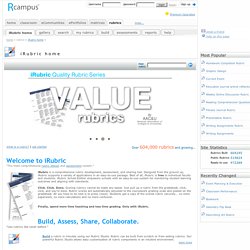
Designed from the ground up, iRubric supports a variety of applications in an easy-to-use package. Best of all, iRubric is free to individual faculty and students. iRubric School-Edition empowers schools with an easy-to-use system for monitoring student learning outcomes and aligning with standards. Click. Click. Assessment and Rubrics. ForAllRubrics - The Rubric & Badging Platform. Assessment Criteria. Fundamentally, assessing multimedia projects is no different from assessing a traditional project, writing assignment or presentation.

The primary difference between traditional assessment and assessing multimedia projects created with technology and web 2.0 tools is that one must consider the unique features and possibilities associated with a specific medium. A podcast for example has a unique set of possibilities that are entirely different from a wiki. Whereas, a wiki would have a completely different set of expectations and requirements when compared to a student video project.
When assessing student work created with technology, it is important to consider the learning curve that is typically associated with using a new technology. Also there is the dual consideration of assessing the process and the product. Webinar slides Simplifying Productive Assessment Tasks. ResourcesfromGreg - Assessment and Rubrics. Principles of Assessment in World Languages The following file contains ruminations from Greg Duncan about what matters in assessment.
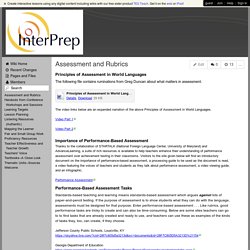
The video links below are an expanded narration of the above Principles of Assessment in World Languages.Video Part 1Video Part 2. Student Learner Profile Assessment Rubric. Student Peer Assessment. Brown, G., Bull, J. and Pendlebury, M. (1997).
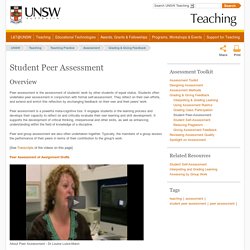
Assessing Student Learning in Higher Education. London: Routledge. Davies, P. (2006). Peer assessment: Judging the quality of students' work by comments rather than marks. Innovations in Education and Teaching International 43(1), 69–82. Dochy, F., Segers, M. and Sluijsmans, D. (1999). Falchikov, N. (1995). Keppell, M.J., Au, E., Ma, A. and Chan, C.M.S. (2006). Step 4: Create the Rubric. Step 4: Create the Rubric Creating an Analytic Rubric Creating a Holistic Rubric Final Step: Checking Your Rubric Workshop: Writing a Good Rubric Note: Before you begin this section I would recommend that you read the section on Rubrics to learn about the characteristics of a good rubric.
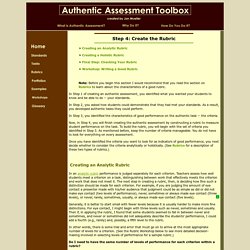
In Step 1 of creating an authentic assessment, you identified what you wanted your students to know and be able to do -- your standards. In Step 2, you asked how students could demonstrate that they had met your standards. As a result, you developed authentic tasks they could perform. In Step 3, you identified the characteristics of good performance on the authentic task -- the criteria. Now, in Step 4, you will finish creating the authentic assessment by constructing a rubric to measure student performance on the task. Once you have identified the criteria you want to look for as indicators of good performance, you next decide whether to consider the criteria analytically or holistically. No. Peer review. Is peer grading an effective assessment method for open and online learning?
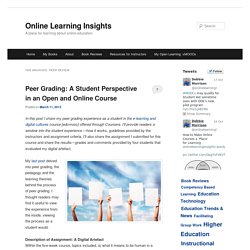
What about in MOOCs where student feedback may be the only means of determining a pass or fail in a course? This posts examine peer grading and suggests what conditions must be present in order for peer grading to be effective. After I wrote the outline for this post I came across this essay, by history professor Jonathon Rees, Why Peer Grading Can’t Work. The title was in stark contrast to my views on peer grading, but I incorporated Rees’ argument here as it is worth consideration. Rees is also author of a blog I follow, More or Less Bunk where he writes about current issues within Higher Education often with a slice of sarcasm. Ideas for Use of Rubrics. Measuring and reporting progress.
The Measurable Gains Framework tools developed for the Māori education strategy Ka Hikitia — Managing for Success 2008–2012 are currently being reviewed so that we will be able to measure and report on progress against the updated strategy Ka Hikitia — Accelerating for Success 2013–2017.

The Measurable Gains Framework tools have been developed to: help define what success (or otherwise) looks like in terms of Ka Hikitia - Managing for Success and how that might be achievedevaluate how much of a difference activities are making towards the overall Ka Hikitia - Managing for Success vision Māori enjoying and achieving education success as Māori; andmeasure and report on progress against Ka Hikitia - Managing for Success. This information will contribute to a better understanding of what works for and with Māori students and will be critical to ongoing improvement. It will contribute to ongoing strategy development, policy and practice. The Measurable Gains Framework tools. 11 Session 102: The Rubric Revolution: Evaluative blending of mixed method evidence. Assessment and Rubrics. Assessment of Project-Based Learning. Project Based Learning Checklists.
KSK Digital Rubrics. Know Your Terms: Holistic, Analytic, and Single-Point Rubrics. So let’s talk about rubrics for a few minutes.
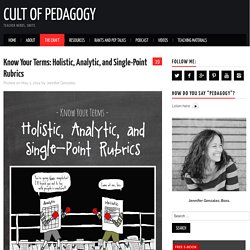
What we’re going to do here is describe two frequently used kinds of rubrics, holistic and analytic, plus a less common one called the single-point rubric (my favorite, for the record). For each one, we’ll look at an example, explore its pros and cons, and provide a blank template you can use to create your own. Off we go! A holistic rubric is the most general kind. It lists three to five levels of performance, along with a broad description of the characteristics that define each level. Suppose you’re an unusually demanding person. When your breakfast is done, you simply gather your loved ones and say, “I’m sorry my darlings, but that breakfast was just a 2. The main advantage of a holistic rubric is that it’s easy on the teacher — in the short run, anyway.
The main disadvantage of a holistic rubric is that it doesn’t provide targeted feedback to students, which means they’re unlikely to learn much from the assignment. Lee Crockett sur Twitter : "4 Types of Accurate Rubric Descriptors #edchat #rubric... Standards and rubrics. Rubric - Griglie di valutazione. Rubrics for Assessing Advanced Forums. Student Reflection and Self Assessment. Assessment. Welcome! Digital Badges. Assessment and Rubrics. Learn more about our Online Courses, Online Certificate Programs, and Graduate Degree A collection of rubrics for assessing portfolios, group work/cooperative learning, concept map, research process/ report, PowerPoint, oral presentation, web page, blog, wiki, and other social media projects.
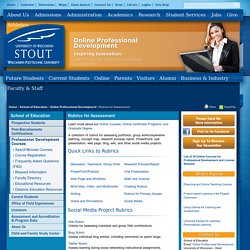
Quick Links to Rubrics Social Media Project Rubrics Wiki RubricCriteria for assessing individual and group Wiki contributions. Blog RubricAssess individual blog entries, including comments on peers' blogs. Twitter RubricAssess learning during social networking instructional assignments. Assessment and Evaluation. Assessment-rubrics. Assessment - self-evaluation. Success Criteria and Learning Targets (Goals) Authentic Assessment & Engagement. Assessments. School Library Evidence & Evaluation Toolkit. Assessment - self-evaluation. Interactive Notebooking. Authentic Assessment & Engagement. Assessments. Bc curriculum links/ documents. Active Learning.